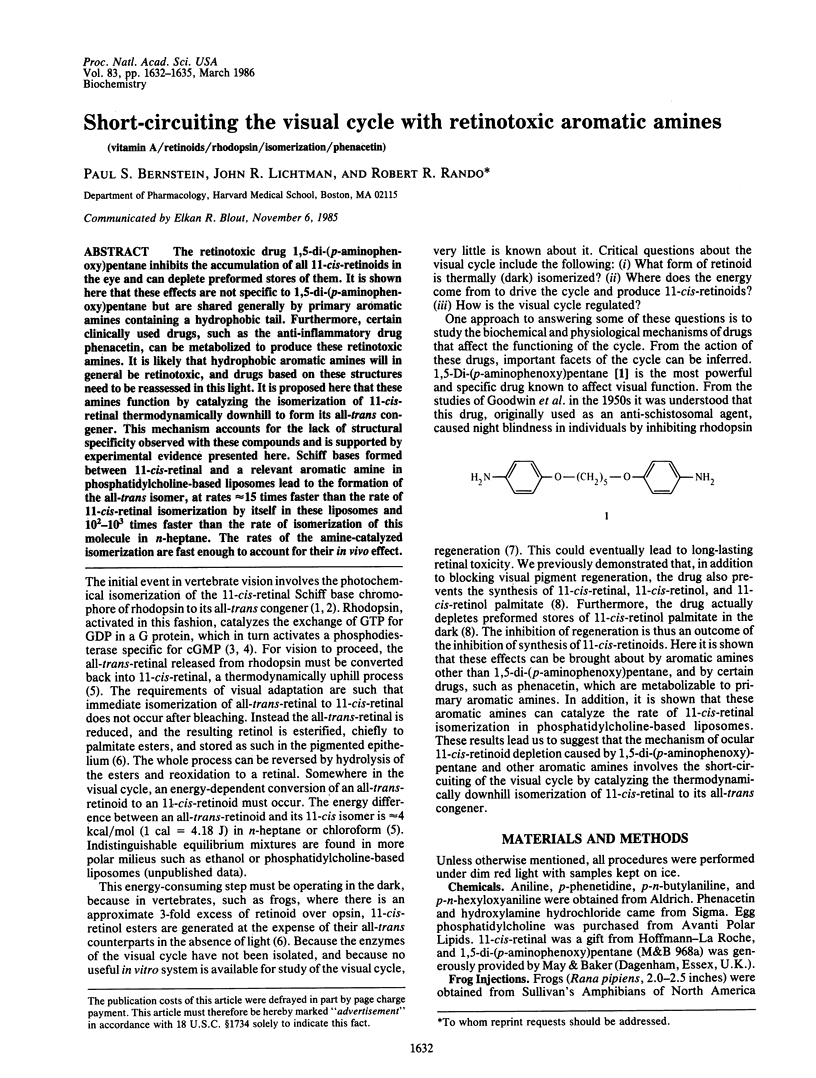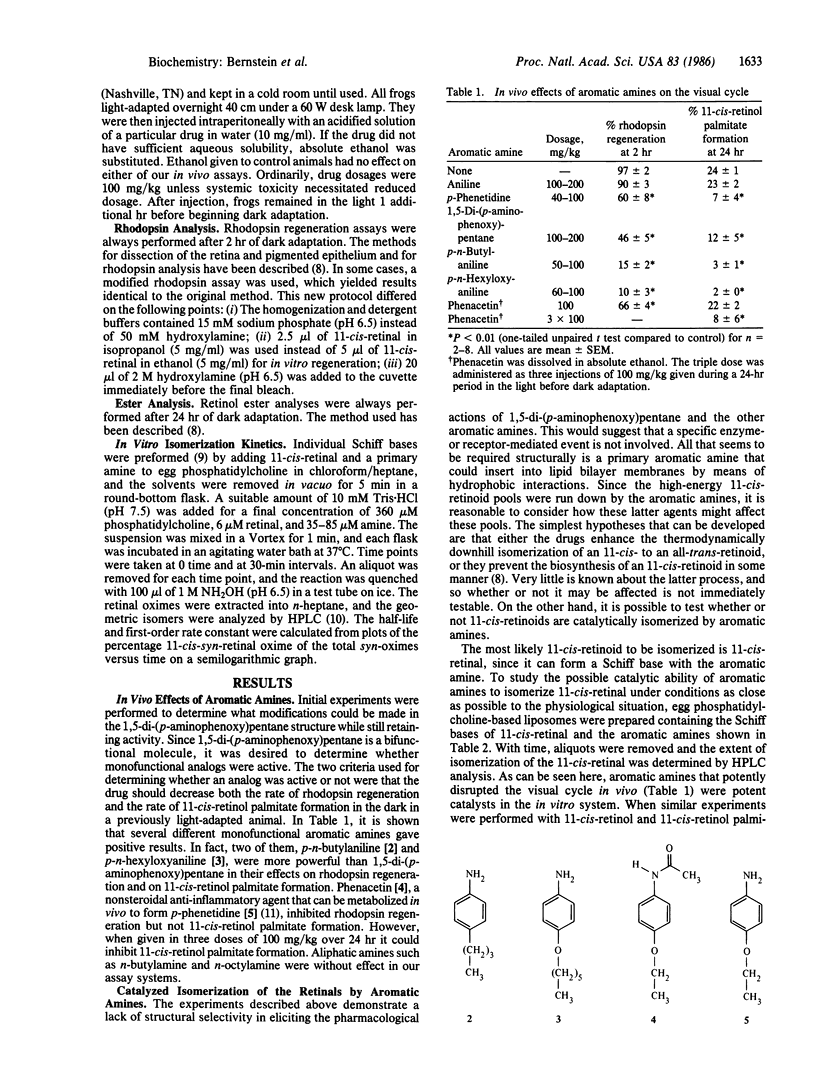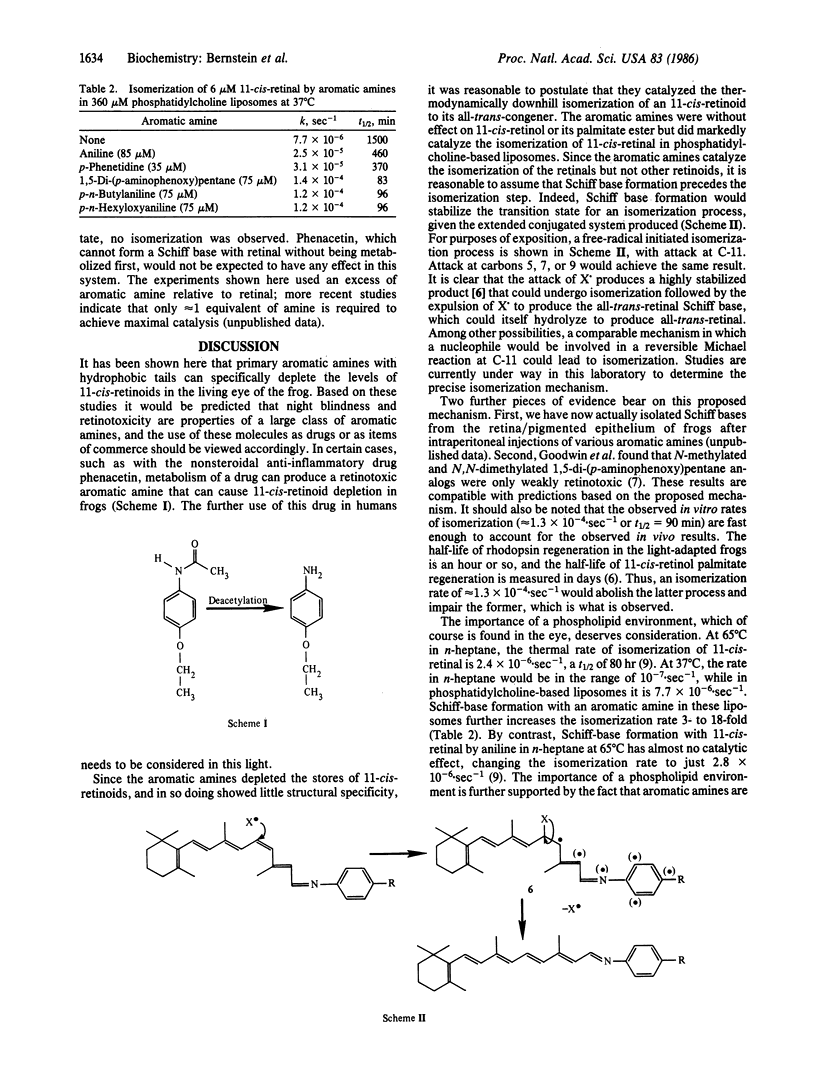Abstract
The retinotoxic drug 1,5-di-(p-aminophenoxy)pentane inhibits the accumulation of all 11-cis-retinoids in the eye and can deplete preformed stores of them. It is shown here that these effects are not specific to 1,5-di-(p-aminophenoxy)pentane but are shared generally by primary aromatic amines containing a hydrophobic tail. Furthermore, certain clinically used drugs, such as the anti-inflammatory drug phenacetin, can be metabolized to produce these retinotoxic amines. It is likely that hydrophobic aromatic amines will in general be retinotoxic, and drugs based on these structures need to be reassessed in this light. It is proposed here that these amines function by catalyzing the isomerization of 11-cis-retinal thermodynamically downhill to form its all-trans congener. This mechanism accounts for the lack of structural specificity observed with these compounds and is supported by experimental evidence presented here. Schiff bases formed between 11-cis-retinal and a relevant aromatic amine in phosphatidylcholine-based liposomes lead to the formation of the all-trans isomer, at rates approximately equal to 15 times faster than the rate of 11-cis-retinal isomerization by itself in these liposomes and 10(2)-10(3) times faster than the rate of isomerization of this molecule in n-heptane. The rates of the amine-catalyzed isomerization are fast enough to account for their in vivo effect.
Full text
PDF



Selected References
These references are in PubMed. This may not be the complete list of references from this article.
- Bernstein P. S., Lichtman J. R., Rando R. R. Nonstereospecific biosynthesis of 11-cis-retinal in the eye. Biochemistry. 1985 Jan 15;24(2):487–492. doi: 10.1021/bi00323a036. [DOI] [PubMed] [Google Scholar]
- Bernstein P. S., Rando R. R. The specific inhibition of 11-cis-retinyl palmitate formation in the frog eye by diaminophenoxypentane, an inhibitor of rhodopsin regeneration. Vision Res. 1985;25(6):741–748. doi: 10.1016/0042-6989(85)90181-6. [DOI] [PubMed] [Google Scholar]
- Bownds D. Site of attachment of retinal in rhodopsin. Nature. 1967 Dec 23;216(5121):1178–1181. doi: 10.1038/2161178a0. [DOI] [PubMed] [Google Scholar]
- Bridges C. D. Vitamin A and the role of the pigment epithelium during bleaching and regeneration of rhodopsin in the frog eye. Exp Eye Res. 1976 May;22(5):435–455. doi: 10.1016/0014-4835(76)90182-2. [DOI] [PubMed] [Google Scholar]
- GOODWIN L. G., RICHARDS W. H., UDALL V. The toxicity of diaminodiphenoxyalkanes. Br J Pharmacol Chemother. 1957 Dec;12(4):468–474. doi: 10.1111/j.1476-5381.1957.tb00167.x. [DOI] [PMC free article] [PubMed] [Google Scholar]
- HUBBARD R. Retinene isomerase. J Gen Physiol. 1956 Jul 20;39(6):935–962. doi: 10.1085/jgp.39.6.935. [DOI] [PMC free article] [PubMed] [Google Scholar]
- HUBBARD R., WALD G. Cis-trans isomers of vitamin A and retinene in the rhodopsin system. J Gen Physiol. 1952 Nov;36(2):269–315. doi: 10.1085/jgp.36.2.269. [DOI] [PMC free article] [PubMed] [Google Scholar]
- Kwok-Keung Fung B., Stryer L. Photolyzed rhodopsin catalyzes the exchange of GTP for bound GDP in retinal rod outer segments. Proc Natl Acad Sci U S A. 1980 May;77(5):2500–2504. doi: 10.1073/pnas.77.5.2500. [DOI] [PMC free article] [PubMed] [Google Scholar]
- Margetts G. Phenacetin and paracetamol. J Int Med Res. 1976;4(4 Suppl):55–70. doi: 10.1177/14732300760040S411. [DOI] [PubMed] [Google Scholar]
- Wheeler G. L., Bitensky M. W. A light-activated GTPase in vertebrate photoreceptors: regulation of light-activated cyclic GMP phosphodiesterase. Proc Natl Acad Sci U S A. 1977 Oct;74(10):4238–4242. doi: 10.1073/pnas.74.10.4238. [DOI] [PMC free article] [PubMed] [Google Scholar]


